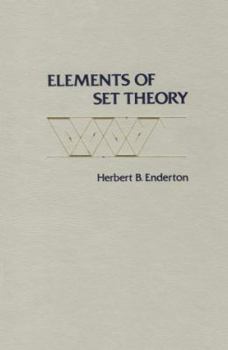Elements of Set Theory
Select Format
Select Condition 
Book Overview
This is an introductory undergraduate textbook in set theory. In mathematics these days, essentially everything is a set. Some knowledge of set theory is necessary part of the background everyone... This description may be from another edition of this product.
Format:Hardcover
Language:English
ISBN:0122384407
ISBN13:9780122384400
Release Date:May 1977
Publisher:Academic Press
Length:296 Pages
Weight:1.30 lbs.
Dimensions:1.1" x 6.3" x 9.3"
Customer Reviews
5 ratings
The Best Intro. Ever!
Published by Thriftbooks.com User , 13 years ago
I might sound biased, but who doesn't? Enderton's book is the BEST introduction out there if you want to learn. There are better books for conciseness or pendanticalness, what a word :(. But, he introduces the material in such a way that the novice can actual absorb most of it in one go through. It's deep enough that a return trip through a difficult chapter is worth your time. After reading this text you can easily segueway to Moschovakis's book, "Notes on Set Theory" or even attempt books like "Set Theory An Introduction To Independence Proofs (Studies in Logic and the Foundations of Mathematics)" by Kunen. This book covers all of the basics of set theory (greater in scope than Halmos's "Naive Set Theory" (which is a great book by the way)).
a good one
Published by Thriftbooks.com User , 13 years ago
not a hard book. Good for a start to get familiar with mathematical ways of thinking.
Good
Published by Thriftbooks.com User , 16 years ago
For some reason I really liked the voice of this book. I really felt like I could curl up by the fire and read this one as if it were some kind of novel. This is rare in math books. I don't know Enderton just seems to put things really clearly. Reading it feels like a real person is talking to me, a nice, fiendly person. It's hard to put down. However, my proffesor liked to stray away from the book, so I was forced to put this book down and instead focus on my proffesor's notes. Enderton is clear, nice to read, and simple. However he jumps straight into the transfinite recursion THM witout really going over the Well ordering principle. Or maybe he addresses it later, my proffesor covered things in a funny order, and I essentially had to read the book in a funny order.
An Excellent Introduction
Published by Thriftbooks.com User , 19 years ago
Perhaps because it is a Foundations book -- in my mathematics training it always seemed that the people who did the best job of motivating and explaining (or at least making you feel you understood) the material were Foundations people -- but this book has a presentation polished to the point where the closest genre of mathematics text in level of polish would be intro calculus books, where the problems theorems and proofs have been worked over for many many many years. Here, however, the material is in great part relatively recent - probably the closest to contemporary stuff you can see as an undergraduate -- in Real Analysis, by contrast, you may well just be coming out of the 19th century by graduate school. This polish, I have discovered in later years, facilitates use of this book for self-study and it is a wonderful text for providing rapid refreshment of important concepts. I have over the years referred back to it on a number of occassions and have always been pleasantly reminded what a wonderful book it is.This is a very nice book and the best introduction to the material I have seen (although, given the number of intro books I have seen on the topic, this may not be a strong statement).
Excellent introduction to set theory
Published by Thriftbooks.com User , 24 years ago
The only reason I won't say it's THE BEST introduction to set theory is that I haven't read ALL such introductions. I am (obviously) a student of logic and I worked my way through the whole book a few years ago. It is an insightful development of set theory, both as a foundation for mathematics and a distinctive mathematical discipline in its own right. Set theory can be developed from a "naive" or an "axiomatic" perspective. The naive approach simply asks the reader to accept arguments about sets on the basis of informed intuition, whereas the axiomatic approach relies on showing how mathematical proofs can be formalized as deductions from a precise axiom system. Enderton's book deftly combines both approaches ; axiomatic considerations are isolated from the rest of the text and identified by a stripe running down the side of the page. Those who are not interested in axioms can avoid dealing with them almost entirely, but enthusiasts of formal rigor (like me!) won't be disappointed either. The axioms, which comprise a system known as Zermelo Fraenkel set theory with Choice, are introduced as needed in the overall development (so Replacement Axioms aren't mentioned until page 179). The text develops relations and functions as well as natural and real number systems, and then goes on to cardinals, orderings, and ordinals. I particularly enjoyed Enderton's well-motivated exposition of ordinals, which clearly shows how these numbers measure the lengths of well-orderings. His treatment of cardinals, transfinite induction, and the Axiom of Choice, is enlightening as well. A final chapter, which includes cofinality and inaccessible cardinals, should whet the student's appetite for further study in set theory. I have a hard time thinking of anything negative to say about this book. Perhaps it would be better if its nicely annotated bibliography were a bit more extensive. If you wanna learn set theory, buy this book!




